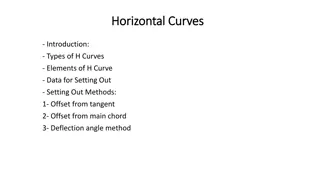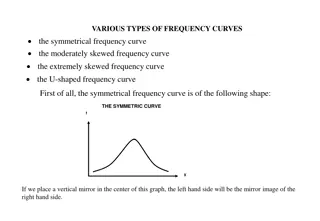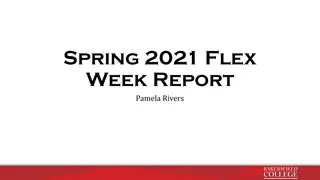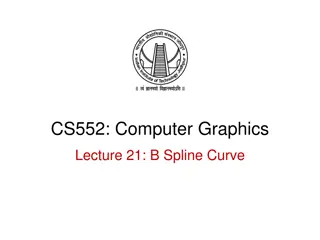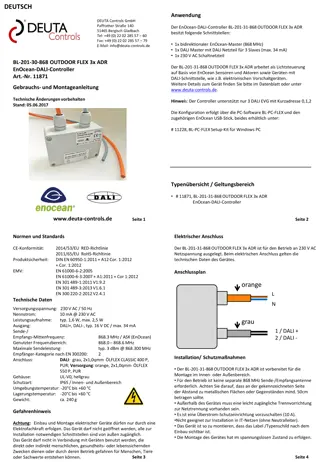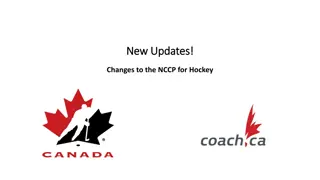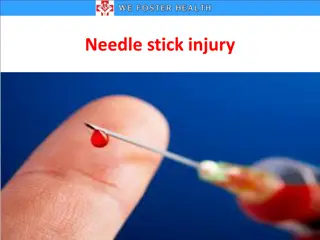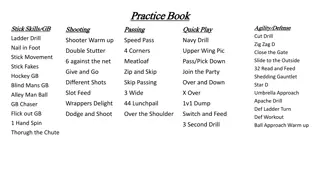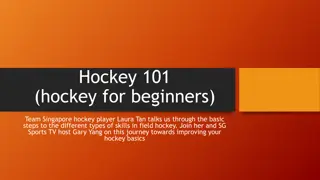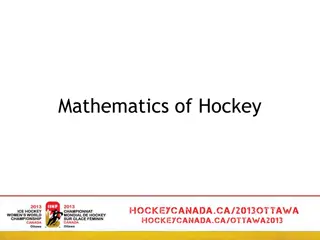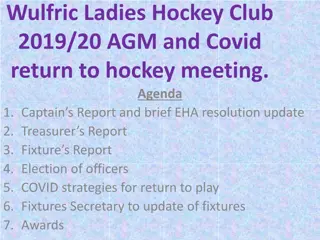Choosing the Right Hockey Stick: Understanding Lies, Flex, and Curves
When purchasing a hockey stick, it goes beyond just color or brand name. Understanding factors like lie angle, flex, and curve pattern is crucial for optimal performance. The lie angle determines how much blade is on the ice, impacting handling and shooting. Flex and length also play key roles in finding the right stick for your playing style. Don't be swayed by trends or price; focus on the stick's characteristics that suit your individual needs.
Download Presentation

Please find below an Image/Link to download the presentation.
The content on the website is provided AS IS for your information and personal use only. It may not be sold, licensed, or shared on other websites without obtaining consent from the author. Download presentation by click this link. If you encounter any issues during the download, it is possible that the publisher has removed the file from their server.
E N D
Presentation Transcript
NOT ALL HOCKEY STICKS ARE THE SAME With hockey stick prices going thru the roof, it is imperative that you purchase the right stick for your player. When shopping for the right stick there is a lot more involved than picking a favorite color, one that matches your team color, or because a fellow teammate has it and Likes it a lot . Here are some questions you NEED to ask before you purchase a stick. What is the Lie? What is the curve pattern? What is the flex? Hockey stores and outlets will heavily discount irregular size lies, curves, and flexes to move thru high inventory levels. The reason the inventory levels are high is because the regular size sticks have already been picked thru. Most times clerks are instructed to move thru this inventory.
NOT ALL HOCKEY STICKS ARE THE SAME THE LIE MATTERS!
Let us look deeper into this and see if I can help to educate the majority of people who are buying the improper stick lie for their skating and playing style. First, the price really plays no factor in whether the stick will help you to score or not. If you do not have the proper lie, flex, length it will not matter if the stick cost you $100.00 or $300.00. With my recent research I have noticed that some stick companies have done way with displaying the sticks lie on the stick itself, but some companies still display it on the upper portion of the shaft. The hockey stick lie refers to the angle of the blade in reference to the shaft. Typical lie values range from 4-7 with most sticks near 5.5. The majority of players will play with a 5- 5.5 lie; this however does not mean it is for everyone. Players look for a lie that will place their blade flat on the ice while they are in their typical skating stance. What you want to do is pick up a stick, grab it in your playing position and get into your skating stance with the stick on the ground or ice. Now look at how much stick blade you have on the surface. If you see lots of light under the toe or heel of the blade you have the wrong lie. Keep trying different sticks, different models, and different blade patterns until you find the one that covers the surface with minimal light showing under the toe or heel of the sticks blade.
Without a doubt, the lie is the most important aspect of a stick because it affects how much blade is on the ice for a particular type of skater and player. Do not feel pressured by the sales associate who is trying to sell you a stick based solely on the fact so-and-so in the NHL is using it. If this should occur perhaps consider spending your money elsewhere at a place who understands how important the stick lie is to handling the puck and shooting the puck. Your overall stick handling and proper puck control will improve when using the proper stick lie for your skating and playing style. The length of your hockey stick will also play a role in finding the correct lie. If you find the correct lie and cut off 4 inches it will bring the blade closer to you and your blade will be mostly on the toe. If this happens then your lie is too low. If you start with a stick that has the correct lie and add inches with a stick plug it will move the blade further from your body and your blade will be mostly on the heel. If this happens then your lie is too high. A lower lie is for the player who likes to skate lower to the ice or in a forward leaning position or players who use a longer stick. Higher lies will keep the puck closer to your body and is preferred by more upright skaters or skaters with shorter sticks.
To know if you are playing with the proper lie now, check the bottom of the blade on one of your well used game sticks. If most of the wear is on the heel, choose a lower lie. If most of the wear is on the toe, choose a higher lie. If the tape is evenly worn across the bottom of the blade you have the right lie for your skating and playing style. - See more at: http://itsourice.com/adams-take-on- lies/#sthash.LC3X2ndp.dpuf
HOCKEY STICK CONVERSION CHARTS LISTED ON THE FOLLOWING SLIDES ARE BRAND CONVERSION CHARTS BASED ON NHL PLAYER NAME AND HOW THEIR STICK PATTERNS CONVERT OVER TO YOU YOU CAN GO ONLINE AND REVIEW OTHER BRANDS IF NEEDED!
STICK FLEX GUIDE With all the different sticks available on the market, it can be hard to choose the right one. Not only are there many models, but curves and flexes can also be a challenge. Picking the right flex is a crucial step. If a player picks a stick that is too soft or too stiff they will not be able to load the stick efficiently. This chart was developed to help guide players, by using two simple criteria, weight and height.
STICK FLEX GUIDE http://ccmhockey.com/sites/all/themes/custom/ccm/assets/images/players-sticks-flexchart-en.png
THE POINT OF THIS IS TO GIVE YOU SOME QUICK INFORMATION TO USE WHEN YOU SHOP FOR YOUR NEXT HOCKEY STICK, OR IF YOU THINK YOUR HOCKEY PLAYER MAY BE HAVING ISSUES WITH THEIR CURRENT STICK. IF YOUR PLAYER IS HAVING PROBLEMS SHOOTING, STICKHANDLING, OR CATCHING PASSES PART OF THE PROBLEM MAY BE THE STICK. THE MOST IMPORTANT THING IS TO DO YOUR HOMEWORK AND FIND THE CORRECT STICK FOR YOUR PLAYER. FROM THERE YOU CAN DECIDE ON COLORS AND SHOP FOR DEALS!


